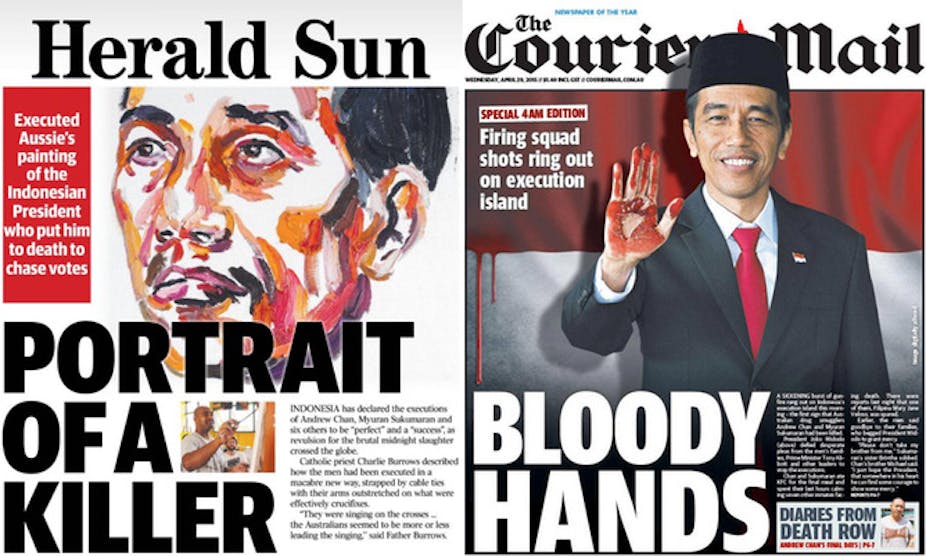There have been executions of Australians for drug offences before. In 1986 Kevin Barlow and Brian Chambers were hung in Malaysia for trafficking heroin. Van Tuong Nguyen was hanged in Singapore in 2005, also for heroin smuggling.
Politicians made protests then too, formal and informal, and there was extensive media coverage of the cases, here and overseas. But nothing like the level of orchestrated outrage and genuine anger seen this week around the judicial deaths of Myuran Sukumaran and Andrew Chan.
The Telegraph ran a blood-drenched image of President Widodo’s face and the words ‘Bad Blood: Joko’s cruel killings batter Indo-Australian relations’. The Herald Sun led with ‘Portrait of a Killer’, and declared ‘Shame’ on his refusal to grant clemency. The Courier Mail depicted Mr Widodo with bloody hands, as the tabloids competed to outdo each other in outraged moral hypocrisy.
Elsewhere in the less opinionated media outlets such as the ABC and Sky News, contrived outrage was dialled down, replaced by hundreds of hours of ‘real time’ news from Indonesia as relatives and reporters assembled, and acres of talking heads commenting on the meanings of this or that legal development.
Brigid Delaney of the Mercy Campaign was asked by Crikey why the coverage had been so intense, replying: “sadly, it’s the hangman’s noose, the proximity to death, the sense of the story being very dramatic”.
All executions are dramatic in this sense, because mediated. Truman Capote’s greatest book was his account of the investigation, trial and executions of Perry Smith and Rick Hickock in his groundbreaking work of literary journalism, In Cold Blood, fifty years ago. Capote wove the true story of an horrific murder in mid-western America into a work of narrative art which made both him and the killers into household names. The public then, as now, finds such spectacle seductive. Editors then, as now, knew that morally laden tales of crime and punishment sell papers, magazines, books and TV news shows.
But coverage of the Chan and Sukumaran executions – the emotional climax of months, indeed years of slow building drama, complete with surprising legal twists, life-affirming rehabilitation, and final, irredeemable tragedy – has been on a qualitatively different scale.
The difference between now and then, I suggest, is not the nature of the public’s fascination with true crime, nor the politicians’ need to play the game of being seen to be in tune with public opinion – jingoistic and xenophobic at one moment, forgiving and reflective the next – but the sheer scale of the media circus now in town.
24-hour news culture needs feeding round the clock, even if there’s nothing to report. Much of the coverage of last week consisted of a journalist standing in darkness, talking to a microphone about what was not happening at any given time, desperate to extract a line or two of meaningful information from a non-communicative and little understood (in Australia, at least) legal system.
This is news, defined not as information about what has happened, but what is happening behind the scenes, maybe, according to sources. The drip-drip of actual new knowledge of the case is merely the framework around which politicians communicate their preferred images of strength, or compassion, or whatever it is that they think the public want to hear in a given political moment.
Chan and Sukumaran received little sympathy from government or media when, as a result of being dobbed in by the AFP, they received their death sentences for smuggling heroin. This week, candles were being lit, tears shed, eulogies written, and ultimately, ambassadors withdrawn for two young men who had came to represent something much more than naïve Australians fallen foul of another country’s well-known if undoubtedly inhumane laws.
It has been a passion play for the Australian public, with Chan and Sukumaran as martyrs. Their judicial murders have been meat and drink for the media, and a kind of macabre entertainment for the public as a whole. The narratives Chan and Sukumaran have generated say more about us than them.

